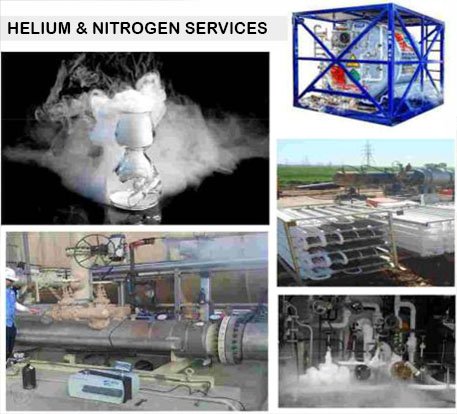

Nitrogen is a colorless, odorless, nontoxic, nonreactive and noncorrosive inert gas thus it can be used for a variety of oil & gas industry. During startups & shutdowns operations nitrogen is the most preferred gas for leak testing operations. Nitrogen Helium Leak Test is the final test, used to prove the integrity of all flanged and threaded joints and connections of piping and all equipment connections. The leak test is designed to demonstrate that process and utility piping systems are properly prepared to operate at specified working pressures.
Nitrogen Applications:
Advantage of using Helium :
Nitrogen Liquid Purging/ Leak test
Nitrogen can be used for a range of similar applications such as line or tank purging, drying, line clearing, pigging or pressure transferring. Below are some examples of purging systems Pressure-hold-vacuum method
This method is commonly used when the vessel being purged only has one opening or in batch operations like purging ethylene oxide sterilizers. Nitrogen is used to pressurize a vessel or line, it mixes with and dilutes the contents and then the diluted mixture is vented to emission control units. This process is repeated until the vessel is sufficiently purged. The ending concentration for each cycle is proportional to the starting concentration and the high and low pressure in the cycle.
Dilution purging and drying
Nitrogen can continuously enter the vessel, dilute the mixture and exhaust through an exit preferably opposite the entrance. The geometry of the vessel and orientation of entry and exit points are important factors in the effectiveness of dilution purging. Drying follows a similar process but allows for removal of residual materials.
Displacement purging and pigging
Nitrogen can be used to purge out a pipe run. A "pig;' a bullet shaped object, can also be pushed through the line using nitrogen gas pressure in order to purge the contents.
Nitrogen Membrane Purging / Leak Test
Compressed air is delivered through stainless-steel flexible hoses to the common manifold for delivery to the membrane bundles in the membrane skid package.
Bundles are composed of millions of polymerbased hair-fine tubes. They are so small, it is critical that moisture, dust, dirt particles, and trace oil vapors be removed prior to processing to protect the membranes. A sophisticated filtration system is included in the membrane skid package. After the air is filtered, it is directed to the header system in the membrane package, which delivers it to a module. A module is a pressure vessel that contains high-pressure membrane bundles. Bundles look like ponytails and are held together with epoxy tube sheets and then cringed into a module. Since the tubes are tightly packed and are of small diameter, void space is minimal.
Since nitrogen is a slower gas, it does not permeate under flowing conditions through the membranes as quickly and travels to the module's discharge outlet. Discharge pressure for the nitrogen is about 350 psig (24 bar) and 110° F (43°(), with a purity of between 5% and 99%. Discharged nitrogen can be utilized at discharge pressure or passed to a downstream compound compressor to further increase pressure if required.